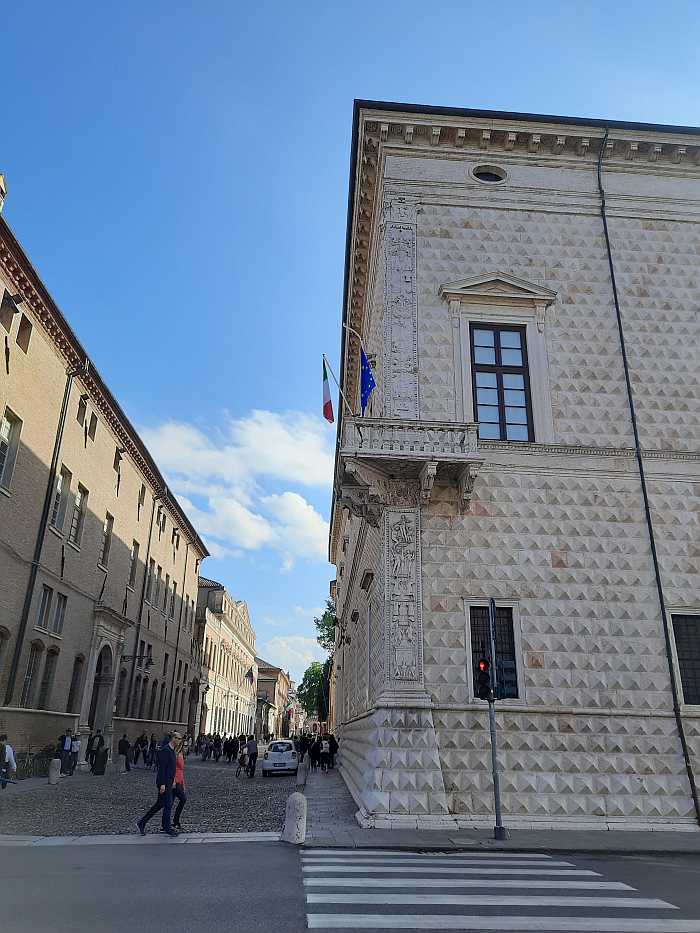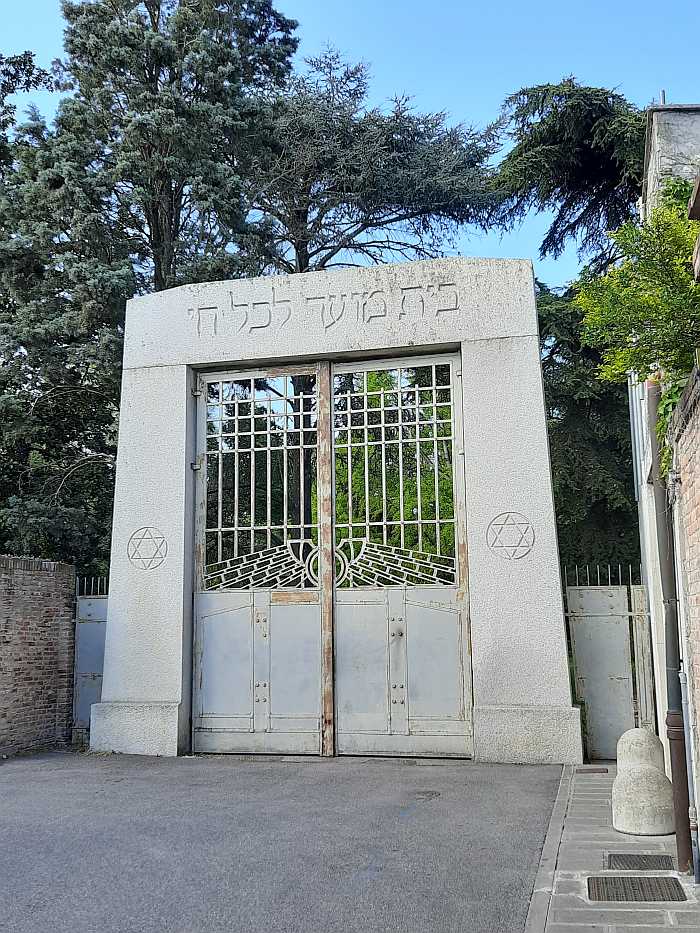
Castle in Ferrara (Photo: Pietro Migliori)
Ferrara, nestled in the northeastern part of Italy within the Emilia-Romagna region, is one of the remarkable pearls of the Italian Renaissance. It is almost perfectly positioned between Bologna, the capital of the region to the south, and the Venice Lagoon to the north, with each approximately 50 kilometers (about 31 miles) away. Ferrara isn't just a jewel of the Italian Renaissance—it's also a living book of Jewish heritage. This city, with its strong Jewish roots woven into its very fabric, invites those interested in exploring both the vibrant tales of the Renaissance and the enduring stories of Jewish history. As you wander its ancient streets, you'll find a special blend of grand Renaissance beauty and the unwavering strength of the city's Jewish community. This is what gives Ferrara its unique charm and character.
The Ghetto Era and the Story of the Jewish Community
The memories of one of the oldest Italian Jewish communities are kept in Ferrara’s medieval quarter. There is documented evidence of Jewish inhabitants tracing back as early as the 13th century. However, it was the enlightened perspective of the city's Renaissance rulers in the 14th and 15th centuries—the Este family—that encouraged Jewish settlement in Ferrara. The Este family was remarkable for their progressive views during the Renaissance, a period characterized by a rebirth of art, culture and humanism. They adopted an open-door policy for Jews, which led to a prosperous Jewish community within the city. This mutual enrichment between Jewish culture and Ferrara’s societal fabric added to the intellectual vibrancy that marked the city's golden age.
However, the Este dynasty's rule concluded in 1598, bringing significant changes for Ferrara's Jewish community. The city fell under the control of the Church, and with this shift in power, numerous restrictions were imposed on the Jewish population culminating in the opening of the Jewish Ghetto. For over two centuries, the Jewish community resided within the confines of the Ferrara Ghetto, until a new era of freedom arrived with the unification of Italy in 1861.


Palazzo dei Diamanti - Diamond's Palace (Photo: Pietro Migliori)
Walking Through History: Via delle Volte
Begin your Jewish experience of Ferrara by breathing the atmosphere of the charming Via delle Volte, one of the oldest streets of Ferrara. It stretches for three kilometers under arches on both of its sides until Via Mazzini (named after one of the founding fathers of the reunification of Italy in the 19th century). This is what used to be the main street of the old ghetto with its old buildings that have maintained their original structure, once home to Jewish homes and shops. At its entrance once stood one of the five gates that closed off the area.
There is a plaque memorializing the opening and dismantling of the ghetto at the time of Italy’s reunification. The rest of the ghetto was bounded by via Vignatagliata, via Vittoria and Piazzetta Isacco Lampronti, featuring houses made of terracotta (some very plain and some with richly decorated archways or with wrought iron balconies). The Ghetto housed the Jewish School where Giorgio Bassani, author of the famous “The Garden of the Finzi Contini”, taught during the time of the Fascist racial laws when Jews were not allowed in the public school system, the matzot oven, the kindergarten and the hospice.
There is a plaque memorializing the opening and dismantling of the ghetto at the time of Italy’s reunification. The rest of the ghetto was bounded by via Vignatagliata, via Vittoria and Piazzetta Isacco Lampronti, featuring houses made of terracotta (some very plain and some with richly decorated archways or with wrought iron balconies). The Ghetto housed the Jewish School where Giorgio Bassani, author of the famous “The Garden of the Finzi Contini”, taught during the time of the Fascist racial laws when Jews were not allowed in the public school system, the matzot oven, the kindergarten and the hospice.
One of Ferrara's two Jewish cemeteries resides in Via delle Vigne, a quiet corner of the old Ghetto. Its history is marked by a painful past; during the 18th century Inquisition, 15th and 16th-century tombstones were sadly removed and repurposed for the renovation of a monumental column. This column now carries the bronze statue of Duca Borso, the illegitimate son of Nicolò III d’Este, standing as a sentinel at one of the entrance gates to the old city.
In the present day, the cemetery offers a peaceful contrast to its turbulent history. Monumental tombs, designed by famous architects during the period of Emancipation, share the space with tranquil green areas. The Emancipation period refers to the time coinciding with the unification of Italy, a transformative era when Jews were granted the same rights and duties as every other Italian citizen. This cemetery now stands as a serene memorial to Ferrara's Jewish heritage, a testament to resilience and the enduring spirit of the community.

Entrance gate to the Jewish cemetery (Photo: Pietro Migliori)
A Historic Hub: Via Mazzini 95 and The Jewish Museum
In your walk through the ghetto you must stop in Via Mazzini 95. This is where the Jewish institutions have been located since 1485 when the building was bought by a rich Roman Jewish banker named Ser Samuel Melli. Here you will find the offices of the local Jewish community and the three surviving synagogues: the former Ashkenazi Synagogue, the Italian synagogue and the Fanese oratory built in the 19th century and still in use today when there is minyan on Shabbat.
Next to the entrance door you will notice two plaques in remembrance of the 1943 Nazi-Fascist deportations with a list of the names of the people that were rounded up and deported to the camps in central Europe. The Jewish Museum is located inside the synagogue. It houses a collection of liturgical and day to day items used by the Jews of the community throughout the centuries as well as 18th century furnishings and documents attesting to events that happened within the community and with the local authorities.
Next to the entrance door you will notice two plaques in remembrance of the 1943 Nazi-Fascist deportations with a list of the names of the people that were rounded up and deported to the camps in central Europe. The Jewish Museum is located inside the synagogue. It houses a collection of liturgical and day to day items used by the Jews of the community throughout the centuries as well as 18th century furnishings and documents attesting to events that happened within the community and with the local authorities.
MEIS: A Modern Tribute to Italian Judaism and the Shoah
It is definitely worth visiting the new Jewish museum, the MEIS (Museum of Italian Judaism and of the Shoah), which was inaugurated in 2017. It is the second largest Jewish Museum in Europe after the one in Berlin. The museum has a 24-minute multimedia exhibit that goes through 2,200 years of Jewish history and culture in Italy. The museum has permanent exhibits about the Holocaust and the story of the Jews in Italy as well as temporary exhibitions. The museum has plans for two more buildings, one of which will have a kosher restaurant and kosher cafeteria.
The Jewish museum is near many famous tourist sights in Ferrara: the Cathedral, the Castle, Palazzo Diamanti, Palazzo Schifanoia, Casa Romei. … all of which are not only beautiful from the outside, but are treasure chests full of incredible surprises for you to visit and discover inside. But they definitely deserve a separate blog of their own…
Andrea Alcalay from La Tour I-Talya. LaTour I-Talya is a project established and managed by a team of Italian Jews working together with one of the largest and most prestigious Italian Tour Operators. LaTour I-Talya specializes in tour packages which focus on the amazingly rich Jewish historical and cultural heritage found throughout Italy.
Read more articles from our Hidden Gems of Italy series:
Echoes of the Past: Unraveling Trieste's Jewish Legacy
Beyond Rome: The Enchanting Villages of Anagni and Alatri
Exploring the Charm of Casale Monferrato
Get in Touch with the oldest Jewish community in Tuscany
The Jewish beauty of Florence
Mantua: First stop in the Renaissance cities of Northern Italy
Pitigliano: "Little Jerusalem" in the Tuscan Maremma Region
Cividale del Friuli: Jewish Tours of Italy off the Beaten Path
The Charming Padova (Padua)
The Marche Region: Undiscovered area of Central Italy